Development and Testing of a Roots Pump for Hydrogen Recirculation in Fuel Cell System
Abstract
- A Roots pump with a new rotor profile for hydrogen recirculation in the PEM fuel cell system is developed.
- The detailed performance of the prototype was measured by a test rig working with hydrogen.
- The comparison of the testing results is presented for the same Roots pump working with air, helium, and hydrogen
- The integration of the Roots pump into a PEM fuel cell system is reported.
1. Introduction
2. Development of the Roots Pump
2.1. Specification Parameters
2.2. Rotor Profile
2.3. Clearances within the Pump
2.4. Suction and Discharge Ports
2.5. Prototype of the Roots Pump
3. Testing of the Roots Pump
3.1. Test Rig
3.2. Data Measurement
3.3. Results and Discussion
3.3.1. Effect of Pressure Difference
3.3.2. Effect of Suction Pressure
3.3.3. Comparison of Performance with Air, Helium, and Hydrogen
4. Integration of the Roots Pump
5. Conclusions
- (1)
- The volume flow rate varies almost linearly with the rotation speed. The requirements of various flow rates for different fuel cell systems can be satisfied by controlling the rotation speed of the Roots pump.
- (2)
- The effect of the pressure difference on the flow rate and volumetric efficiency of the Roots pump is significant, and the effect of the suction pressure is limited.
- (3)
- Leakage is the key factor which has a major influence on the volumetric and isentropic efficiency of the Roots pump, while the impact of flow resistance is insignificant.
- (4)
- The performance of the Roots pump is highly sensitive to the property of the working gas. The measured values of volume flow rate and volumetric efficiency are quite different when the same Roots pump operates with air, helium, and hydrogen.
- (5)
- The performance of the Roots pump integrated into the fuel cell system is better than that measured with pure hydrogen on the pump test rig. This implies that the effects of the water and nitrogen that existed inevitably in the recirculating hydrogen on the performance of the Roots pump are worth studying further.
Author Contributions
Funding
Conflicts of Interest
Abbreviations
| A0 | Area between two lobes of the rotor and the casing, mm2 |
| k | Isentropic index |
| L | Rotor length, mm |
| n | Rotation speed of the rotor, rpm |
| P | Pressure, kPa |
| ΔP | Pressure difference, kPa |
| Q | Volume flow rate, L/min |
| Ro | Tip radius, mm |
| Rp | Pith radius, mm |
| N | Power consumption, W |
| Z | lobe numbers of the rotor |
| Greek symbols | |
| ηis | Isentropic efficiency |
| ηv | Volumetric efficiency |
| Subscripts | |
| d | Discharge |
| s | Suction |
| th | Theoretical |
References
- Wilberforce, T.; Alaswad, A.; Palumbo, A.; Dassisti, M.; Olabi, A. Advances in stationary and portable fuel cell applications. Int. J. Hydrog. Energy 2016, 41, 16509–16522. [Google Scholar] [CrossRef]
- Dubau, L.; Castanheira, L.; Maillard, F.; Chatenet, M.; Lottin, O.; Maranzana, G.; Dillet, J.; Lamibrac, A.; Perrin, J.-C.; Moukheiber, E.; et al. A review of PEM fuel cell durability: Materials degradation, local heterogeneities of aging and possible mitigation strategies. Wiley Interdiscip. Rev. Energy Environ. 2014, 3, 540–560. [Google Scholar] [CrossRef]
- Jahnke, T.; Futter, G.; Latz, A.; Malkow, T.; Papakonstantinou, G.; Tsotridis, G.; Schott, P.; Gerard, M.; Quinaud, M.; Quiroga, M.A.; et al. Performance and degradation of Proton Exchange Membrane Fuel Cells: State of the art in modeling from atomistic to system scale. J. Power Sources 2016, 304, 207–233. [Google Scholar] [CrossRef]
- Wang, Y.; Diaz, D.F.R.; Chen, K.S.; Wang, Z.; Adroher, X.C. Materials, technological status, and fundamentals of PEM fuel cells—A review. Mater. Today 2020, 32, 178–203. [Google Scholar] [CrossRef]
- Shen, K.-Y.; Park, S.; Kim, Y.-B. Hydrogen utilization enhancement of proton exchange membrane fuel cell with anode recirculation system through a purge strategy. Int. J. Hydrog. Energy 2020, 45, 16773–16786. [Google Scholar] [CrossRef]
- Shao, Y.; Xu, L.; Zhao, X.; Li, J.; Hu, Z.; Fang, C.; Hu, J.; Guo, D.; Ouyang, M. Comparison of self-humidification effect on polymer electrolyte membrane fuel cell with anodic and cathodic exhaust gas recirculation. Int. J. Hydrog. Energy 2020, 45, 3108–3122. [Google Scholar] [CrossRef]
- Kim, M.S.; Kim, D.K. Parametric study on dynamic heat and mass transfer response in polymer electrolyte membrane fuel cell for automotive applications. Appl. Therm. Eng. 2020, 167, 114729. [Google Scholar] [CrossRef]
- He, J.; Choe, S.-Y.; Hong, C.-O. Analysis and control of a hybrid fuel delivery system for a polymer electrolyte membrane fuel cell. J. Power Sources 2008, 185, 973–984. [Google Scholar] [CrossRef]
- He, H.; Quan, S.; Wang, Y.-X. Hydrogen circulation system model predictive control for polymer electrolyte membrane fuel cell-based electric vehicle application. Int. J. Hydrog. Energy 2020, 45, 20382–20390. [Google Scholar] [CrossRef]
- Toghyani, S.; Afshari, E.; Baniasadi, E. A parametric comparison of three fuel recirculation system in the closed loop fuel supply system of PEM fuel cell. Int. J. Hydrog. Energy 2019, 44, 7518–7530. [Google Scholar] [CrossRef]
- Toghyani, S.; Baniasadi, E.; Afshari, E. Performance analysis and comparative study of an anodic recirculation system based on electrochemical pump in proton exchange membrane fuel cell. Int. J. Hydrog. Energy 2018, 43, 19691–19703. [Google Scholar] [CrossRef]
- Feng, J.; Han, J.; Hou, T.; Peng, X. Performance analysis and parametric studies on the primary nozzle of ejectors in proton exchange membrane fuel cell systems. Energy Sources Part A Recover. Util. Environ. Eff. 2020. [Google Scholar] [CrossRef]
- Han, J.; Feng, J.; Hou, T.; Peng, X. Performance investigation of a multi-nozzle ejector for proton exchange membrane fuel cell system. Int. J. Energy Res. 2020, 1–18. [Google Scholar] [CrossRef]
- Badami, M.; Mura, M. Theoretical model with experimental validation of a regenerative blower for hydrogen recirculation in a PEM fuel cell system. Energy Convers. Manag. 2010, 51, 553–560. [Google Scholar] [CrossRef]
- Badami, M.; Mura, M. Leakage effects on the performance characteristics of a regenerative blower for the hydrogen recirculation of a PEM fuel cell. Energy Convers. Manag. 2012, 55, 20–25. [Google Scholar] [CrossRef]
- Wang, J.; Jiang, X.; Cai, Y. Investigation of a novel circular arc claw rotor profile for claw vacuum pumps and its performance analysis. Vacuum 2015, 111, 102–109. [Google Scholar] [CrossRef]
- Zhang, Q.; Feng, J.; Wen, J.; Peng, X. 3D transient CFD modelling of a scroll-type hydrogen pump used in FCVs. Int. J. Hydrog. Energy 2018, 43, 19231–19241. [Google Scholar] [CrossRef]
- Zhang, Q.; Feng, J.; Zhang, Q.; Peng, X. Performance prediction and evaluation of the scroll-type hydrogen pump for FCVs based on CFD–Taguchi method. Int. J. Hydrog. Energy 2019, 44, 15333–15343. [Google Scholar] [CrossRef]
- Konno, N.; Mizuno, S.; Nakaji, H.; Ishikawa, Y. Development of Compact and High-Performance Fuel Cell Stack. SAE Int. J. Altern. Powertrains 2015, 4, 123–129. [Google Scholar] [CrossRef]
- Xing, L.; He, Y.; Wen, J.; Peng, X. Three-dimensional CFD Modelling of a Roots Blower for Hydrogen Recirculation in Fuel Cell System. In 2018 International Compressor Engineering Conference; Purdue University: West Lafayette, IN, USA, 2018; p. 2562. Available online: https://docs.lib.purdue.edu/icec/2562 (accessed on 21 December 2018).
- Wang, P.-Y.; Fong, Z.-H.; Fang, H.S. Design constraints of five-arc Roots vacuum pumps. Proc. Inst. Mech. Eng. Part C J. Mech. Eng. Sci. 2002, 216, 225–234. [Google Scholar] [CrossRef]
- Hsieh, C.-F.; Hwang, Y.-W. Study on the High-Sealing of Roots Rotor with Variable Trochoid Ratio. J. Mech. Des. 2006, 129, 1278–1284. [Google Scholar] [CrossRef]
- Burmistrov, A.; Belyaev, L.; Ossipov, P.; Fomina, M.; Khannanov, R. Combined experimental and calculation study of conductance of Roots pump channels. Vacuum 2001, 62, 331–335. [Google Scholar] [CrossRef]
- Sun, S.-K.; Zhao, B.; Jia, X.-H.; Peng, X.-Y. Three-dimensional numerical simulation and experimental validation of flows in working chambers and inlet/outlet pockets of Roots pump. Vacuum 2017, 137, 195–204. [Google Scholar] [CrossRef]
- Singh, G.; Sun, S.; Kovacevic, A.; Li, Q.; Bruecker, C. Transient flow analysis in a Roots blower: Experimental and numerical investigations. Mech. Syst. Signal Process. 2019, 134, 106305. [Google Scholar] [CrossRef]
- Mimmi, G.; Pennacchi, P. Compression Load Dynamics in a Special Helical Blower: A Modeling Improvement. J. Mech. Des. 1999, 123, 402–407. [Google Scholar] [CrossRef]
- Yao, L.; Ye, Z.; Dai, J.S.; Cai, H. Geometric analysis and tooth profiling of a three-lobe helical rotor of the Roots blower. J. Mater. Process. Technol. 2005, 170, 259–267. [Google Scholar] [CrossRef]
- Hsieh, C.-F.; Zhou, Q.-J. Fluid analysis of cylindrical and screw type Roots vacuum pumps. Vacuum 2015, 121, 274–282. [Google Scholar] [CrossRef]
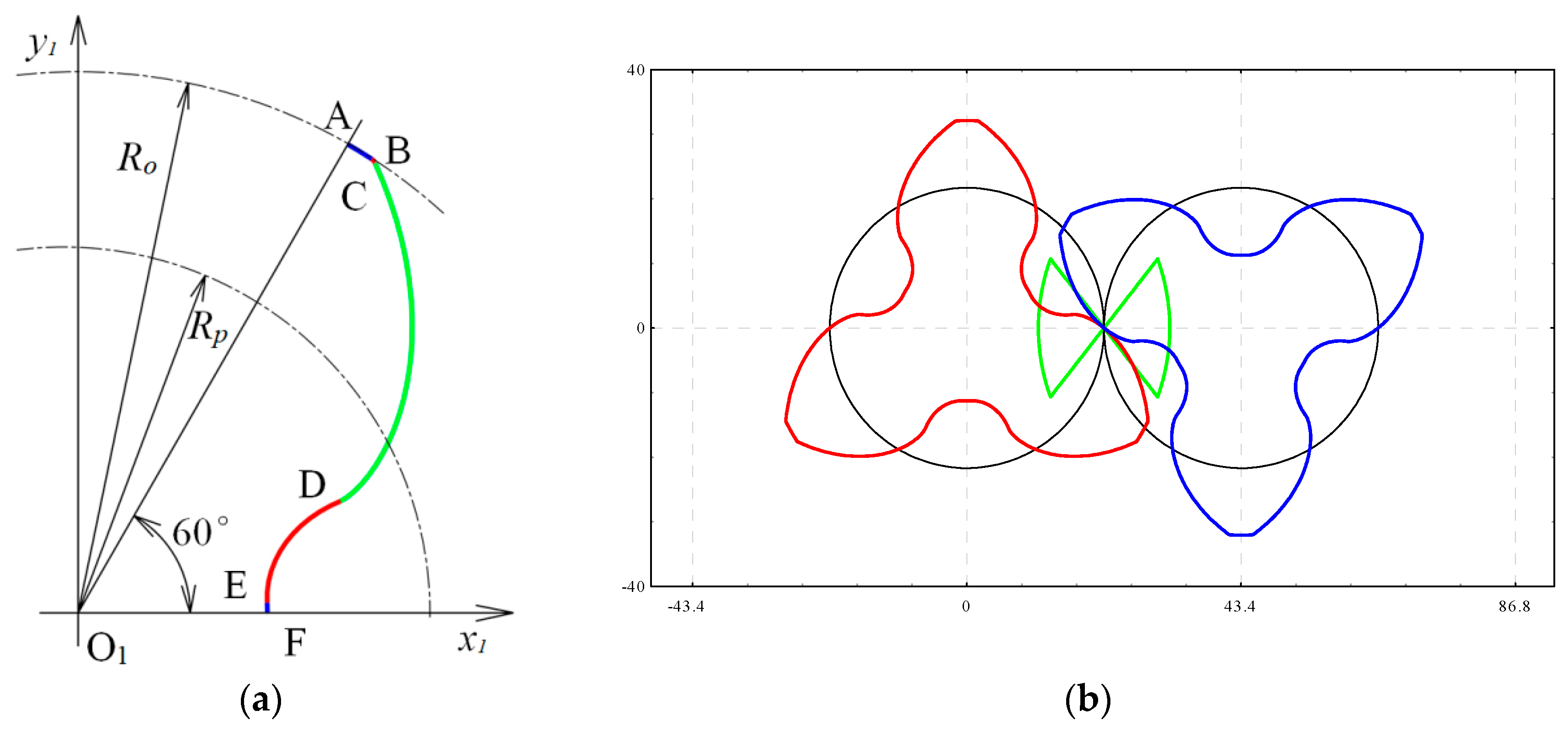
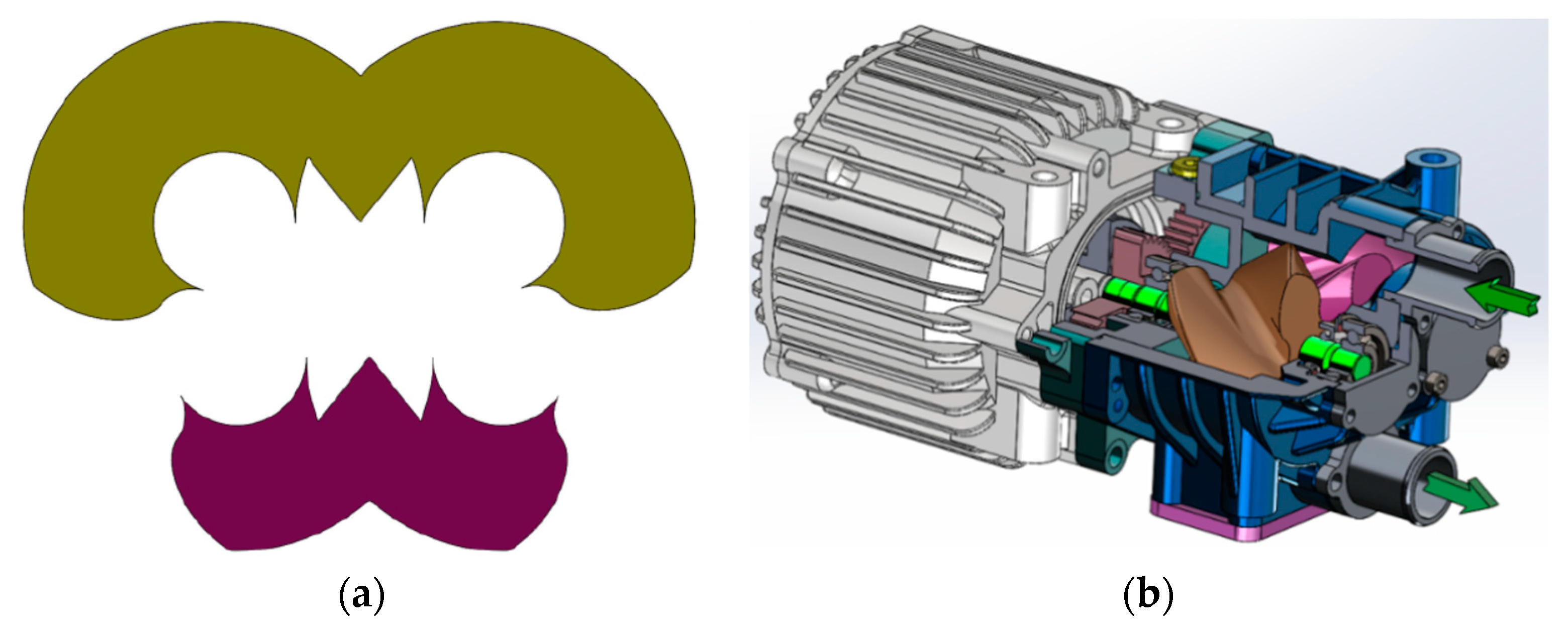
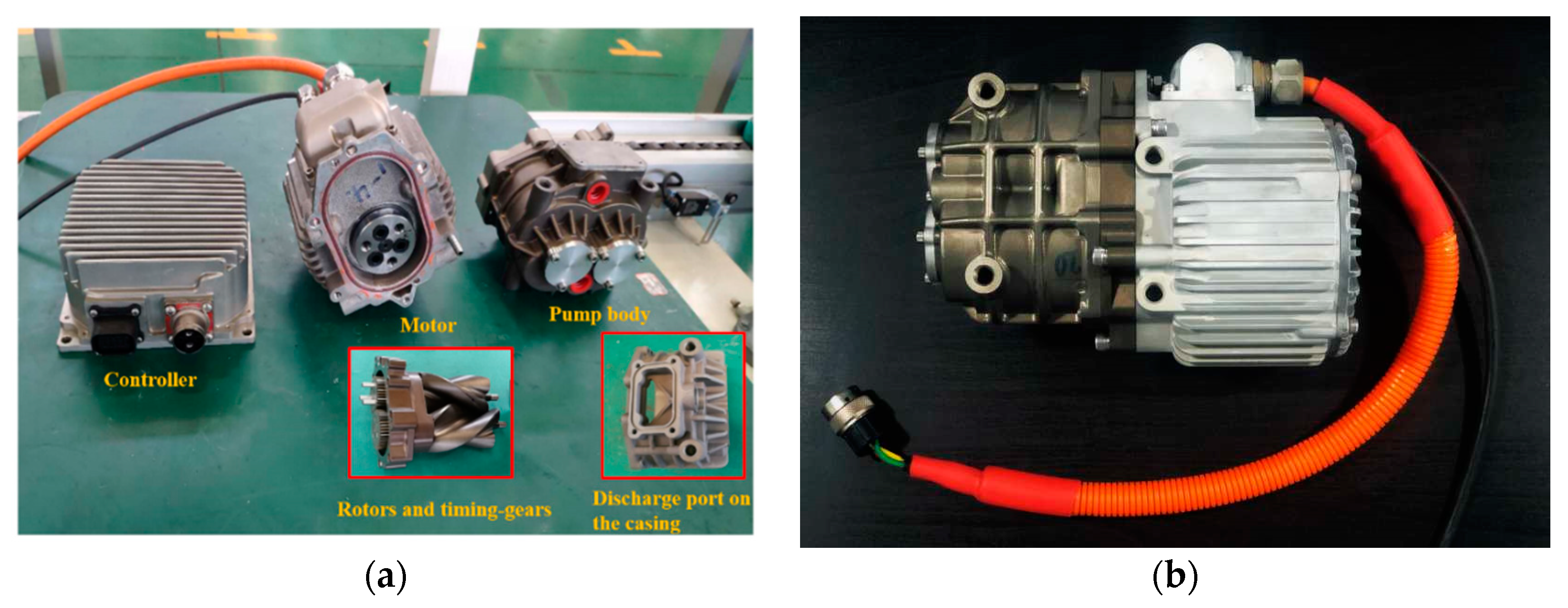
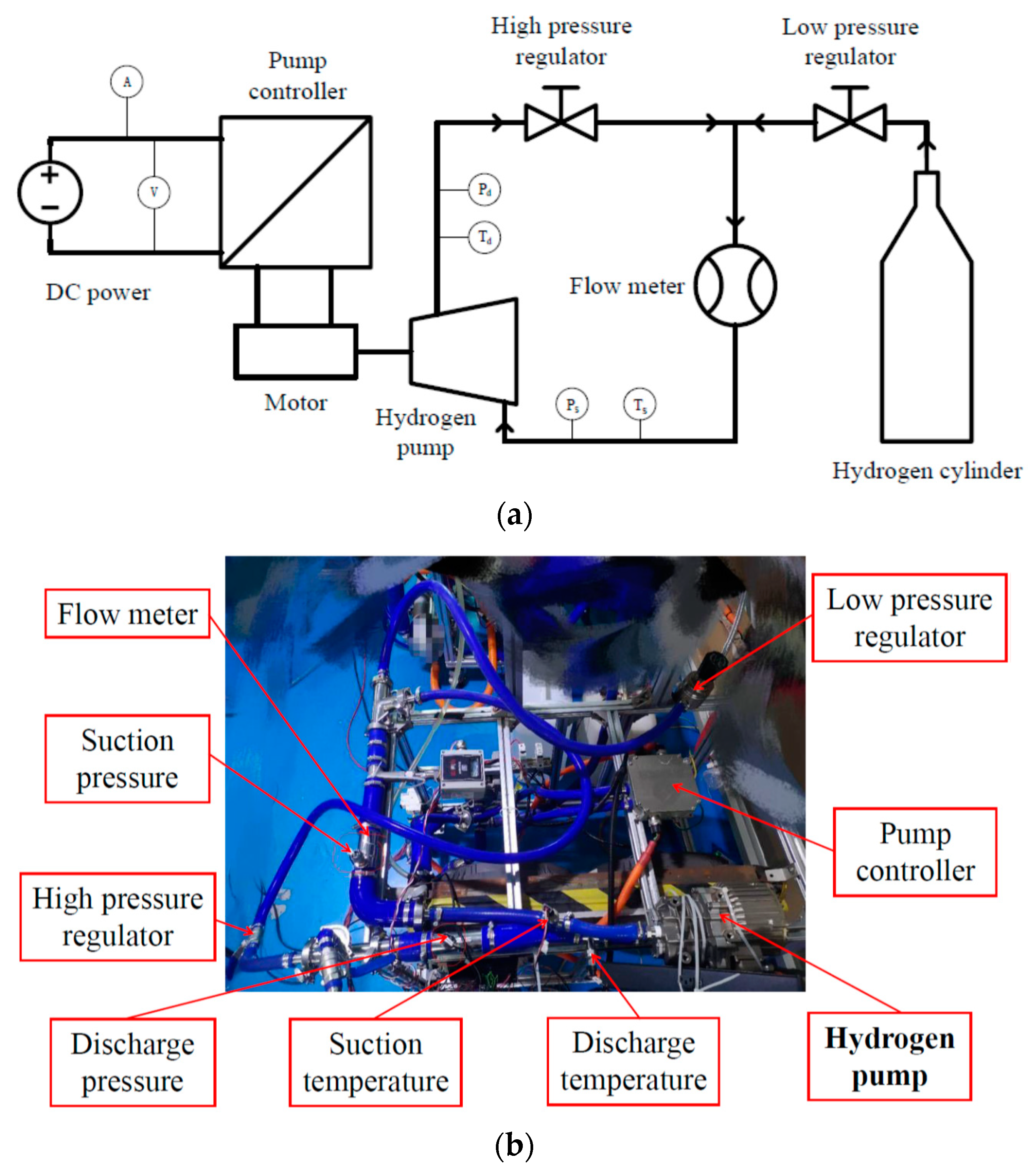
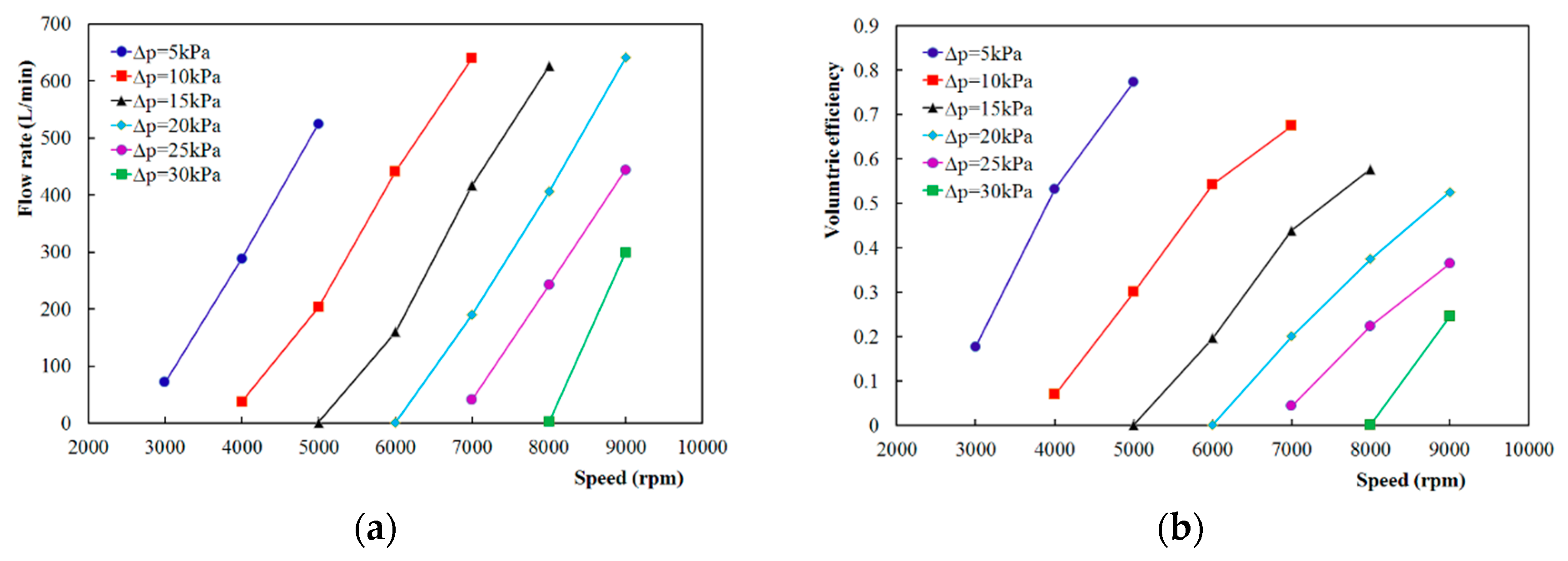
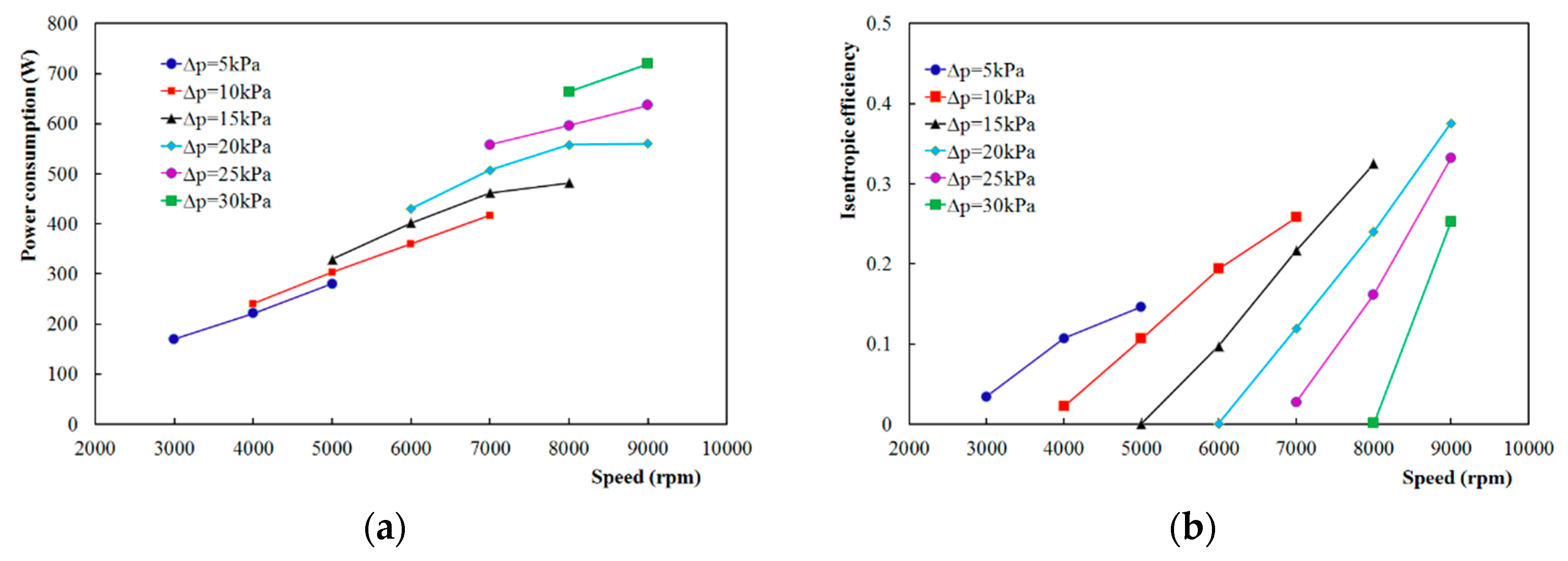
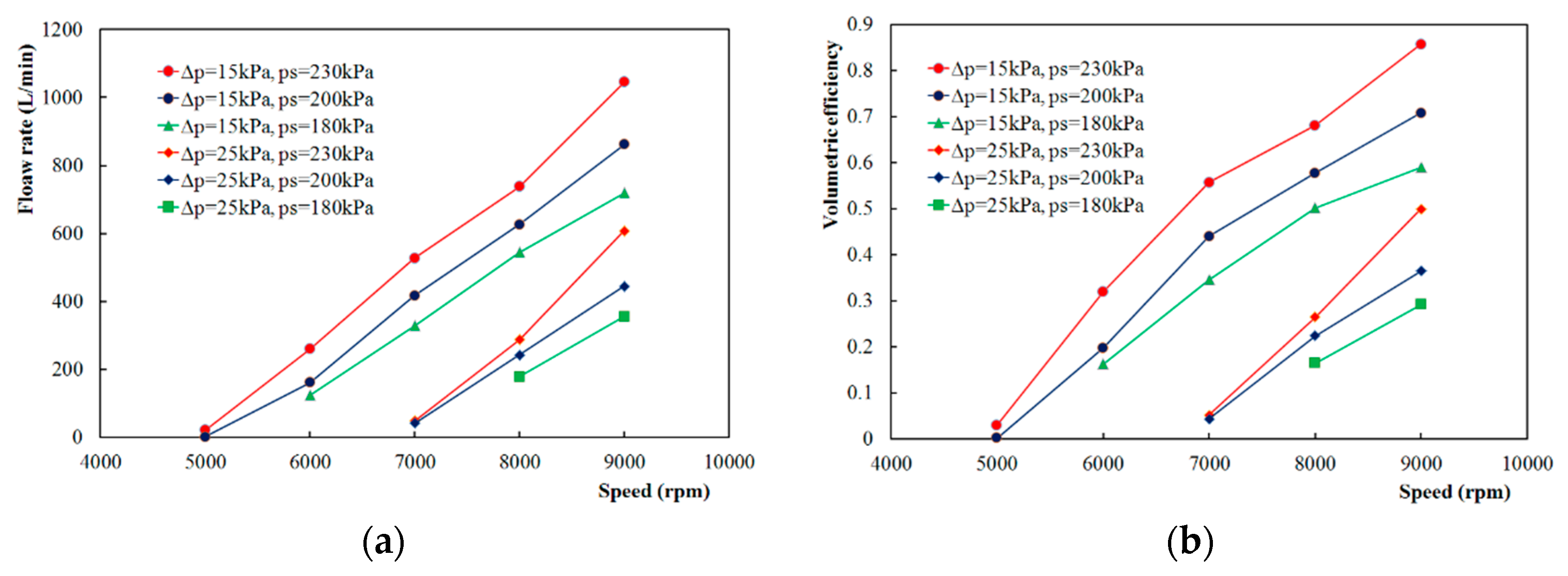
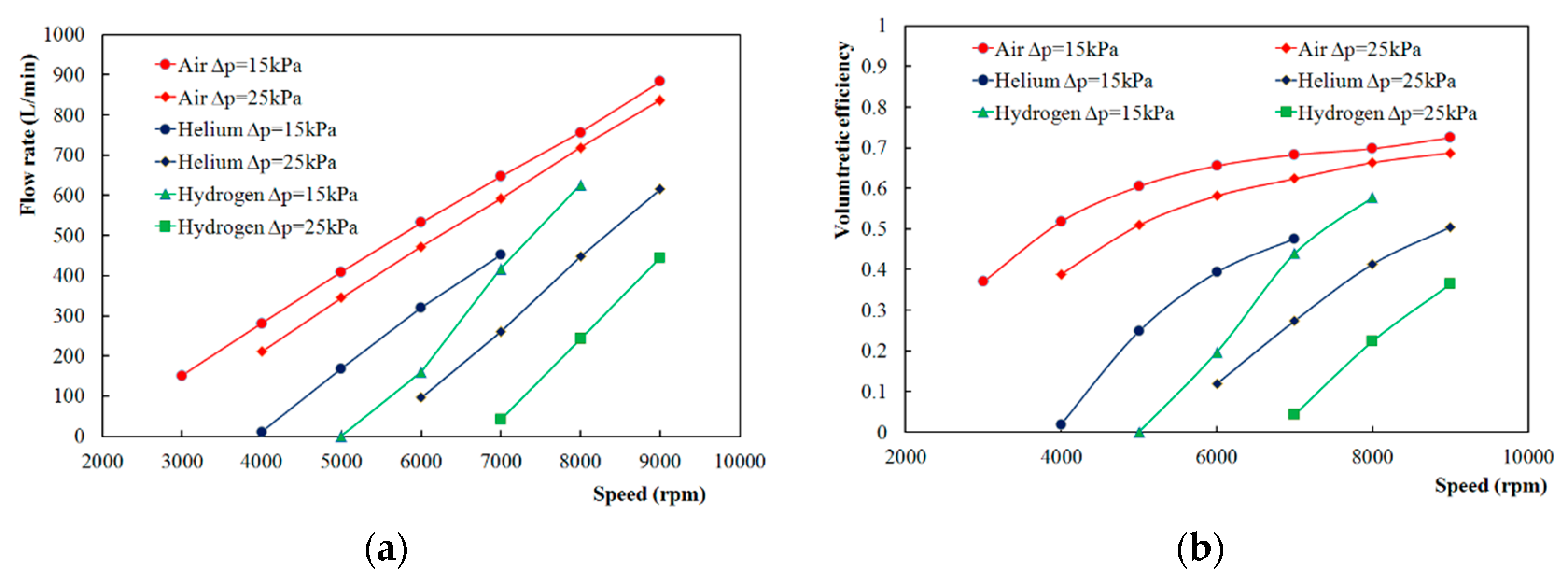
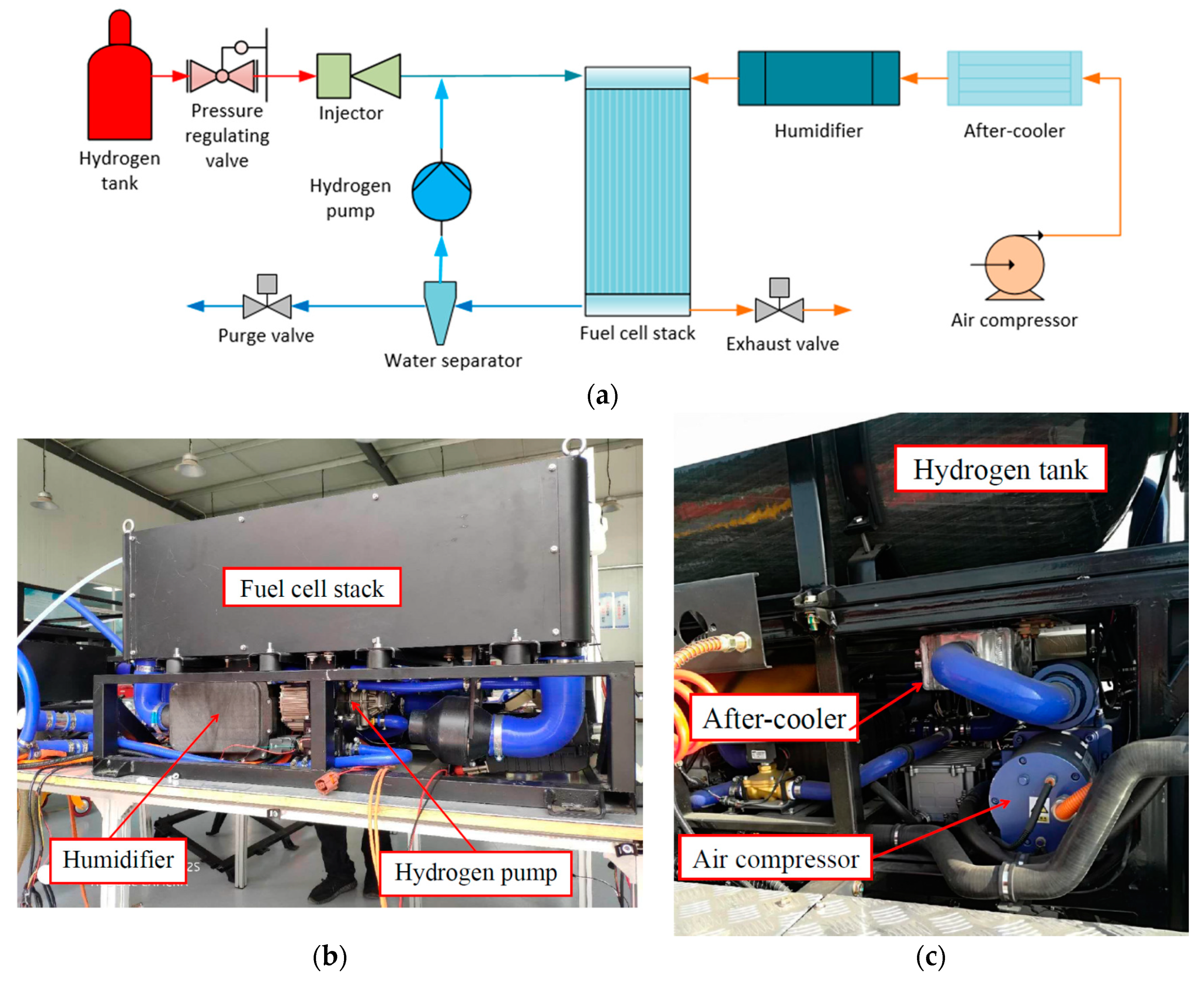
| Parameters | Value |
|---|---|
| Volume flow rate (L/min) | 500 |
| Suction temperature (°C) | 80 |
| Suction pressure (kPa) | 180–220 |
| Pressure difference (kPa) | >20 |
| Parameters | Value |
|---|---|
| Lobes of rotor | 3 |
| Center distance between the rotors(mm) | 43.4 |
| Outside diameter of rotor(mm) | 64.2 |
| Length of the rotor (mm) | 40 |
| Wrap angle of the rotor (°) | 95 |
| Theoretical capacity per rotation (L) | 0.135 |
| Rated rotation speed of the rotor (rpm) | 8000 |
| Tip peripheral speed of the rotor(m/s) | 26.9 |
| Theoretical volume flow rate (L/min) | 1082 |
| Parameters | Value | |||||
|---|---|---|---|---|---|---|
| Load of the fuel cell | 100% | 25% | ||||
| Power of the fuel cell (kW) | 60 | 80 | 110 | 15 | 20 | 27.5 |
| Pressure difference (kPa) | 25 | 29.5 | 32 | 10 | 9.6 | 13 |
| Power consumption of the Roots pump (W) | 535 | 695 | 850 | 180 | 235 | 280 |
| Rotation speed of the Roots pump (rpm) | 5400 | 7000 | 8000 | 3000 | 4600 | 5500 |
Publisher’s Note: MDPI stays neutral with regard to jurisdictional claims in published maps and institutional affiliations. |
© 2020 by the authors. Licensee MDPI, Basel, Switzerland. This article is an open access article distributed under the terms and conditions of the Creative Commons Attribution (CC BY) license (http://creativecommons.org/licenses/by/4.0/).
Share and Cite
Xing, L.; Feng, J.; Chen, W.; Xing, Z.; Peng, X. Development and Testing of a Roots Pump for Hydrogen Recirculation in Fuel Cell System. Appl. Sci. 2020, 10, 8091. https://doi.org/10.3390/app10228091
Xing L, Feng J, Chen W, Xing Z, Peng X. Development and Testing of a Roots Pump for Hydrogen Recirculation in Fuel Cell System. Applied Sciences. 2020; 10(22):8091. https://doi.org/10.3390/app10228091
Chicago/Turabian StyleXing, Linfen, Jianmei Feng, Wenqing Chen, Ziyi Xing, and Xueyuan Peng. 2020. "Development and Testing of a Roots Pump for Hydrogen Recirculation in Fuel Cell System" Applied Sciences 10, no. 22: 8091. https://doi.org/10.3390/app10228091
APA StyleXing, L., Feng, J., Chen, W., Xing, Z., & Peng, X. (2020). Development and Testing of a Roots Pump for Hydrogen Recirculation in Fuel Cell System. Applied Sciences, 10(22), 8091. https://doi.org/10.3390/app10228091





